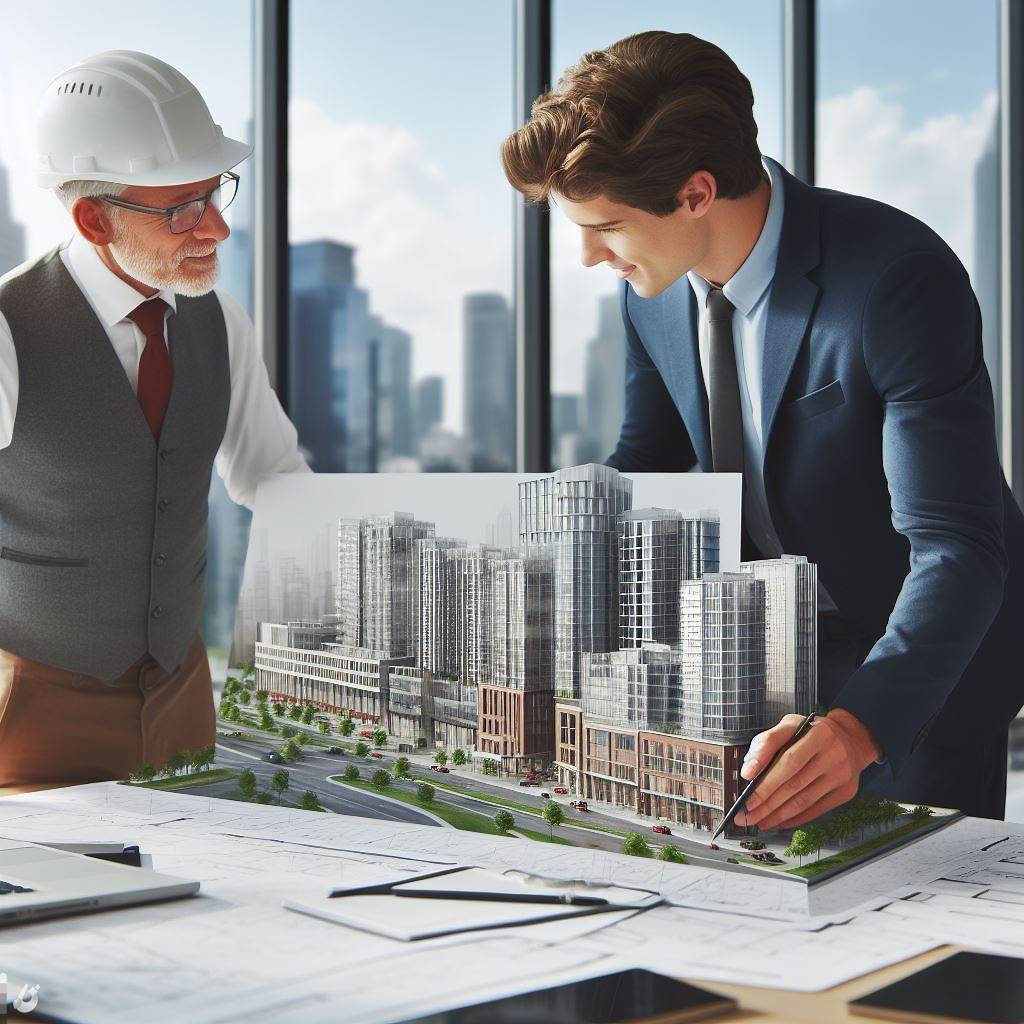Introduction
The world of commercial property developments is currently in a dynamic phase.
We witness a shift towards sustainability and innovation.
Exploring the future of this sector is crucial for anticipating and embracing forthcoming trends and advancements.
A glance at the present state reveals a landscape undergoing transformative changes.
Sustainability initiatives, technological integrations, and adaptive designs are becoming more prevalent.
These trends not only reflect the current ethos but also set the stage for what lies ahead.
Discussing the future of commercial property developments is more than speculation; it’s a strategic imperative.
It allows stakeholders to prepare for shifting market demands, evolving consumer preferences, and emerging technologies.
The significance of this discussion extends beyond mere curiosity. It enables industry professionals, investors, and developers to stay ahead of the curve.
By understanding the current landscape and forecasting future trajectories, it becomes possible to proactively shape the future of commercial property developments.
Embracing these insights is instrumental in adapting and thriving in an ever-evolving market scenario.
Read: Navigating Zoning Laws in Property Development
Recent Trends in Commercial Property Developments
In recent years, the future of commercial property developments has been shaped by various trends and advancements.
This section, explores some of the most notable developments in the industry.
Incorporation of sustainability and green initiatives
A major trend in commercial property developments is the incorporation of sustainability and green initiatives.
Commercial properties that embrace sustainable features have been proven to offer advantages such as reduced energy consumption and lower operating costs.
These properties often integrate renewable energy sources and feature energy-efficient designs, such as efficient lighting and insulation.
Numerous examples of sustainable commercial developments can be found worldwide.
One notable certification for sustainable buildings is LEED (Leadership in Energy and Environmental Design), which provides a framework for environmentally friendly construction.
Many commercial properties have achieved LEED certification, showcasing their commitment to sustainability.
Additionally, developments utilizing renewable energy sources, such as solar panels and geothermal systems, demonstrate the growing adoption of sustainable practices in the industry.
Flexibility and adaptability in design and usage
Another significant trend in commercial property developments is the emphasis on flexibility and adaptability in design and usage.
Mixed-use developments, which combine residential, commercial, and recreational spaces in one location, have gained popularity.
The integration of different functions in a single development allows for increased convenience and efficiency.
Businesses and residents can enjoy the proximity of amenities, reducing the need for long commutes and fostering a sense of community.
Adaptive spaces within commercial properties are also becoming increasingly important.
These spaces can be easily reconfigured or repurposed to accommodate changing needs.
For example, an office space that can transform into a collaborative area or a retail store that can be converted into a pop-up shop.
The ability to adapt to evolving trends and requirements makes these properties more attractive to businesses and tenants.
Furthermore, commercial property developments are embracing advancements in technology.
Smart building systems have emerged, integrating technology to optimize various aspects of property management.
These systems use sensors and automation to control lighting, HVAC systems, and security.
Additionally, they provide data on energy usage and building performance, allowing for effective monitoring and optimization.
Embracing technology advancements
The impact of advanced technology on property management cannot be overlooked.
Artificial intelligence and data analytics enable property managers to make data-driven decisions, improving efficiency and predicting maintenance needs.
Automated processes, such as tenant communication and maintenance requests, streamline operations.
The use of technology enhances tenant experience, making properties more attractive to current and prospective tenants.
Overall, recent trends in commercial property developments showcase a shift towards sustainability, flexibility, and technological advancements.
Building sustainable properties, offering adaptable spaces, and integrating smart building systems are key factors shaping the future of the industry.
These developments not only benefit businesses and tenants but also contribute to a more efficient and environmentally conscious built environment.
Read: The Rise of Tiny Homes: Development Insights
Emerging Concepts and Innovations
Co-working spaces and shared offices
Co-working spaces and shared offices have emerged as game-changers in the commercial property industry.
Businesses are increasingly embracing this concept due to its numerous benefits.
Co-working spaces provide flexibility, cost-effectiveness, and networking opportunities.
By sharing office spaces, businesses can save on rental costs and easily scale up or down based on their needs.
Moreover, co-working spaces foster collaboration and innovation through the interactions among different professionals and companies.
However, there are potential challenges to consider. Co-working spaces may lack privacy and confidentiality, which can be crucial for certain businesses.
Moreover, the future prospects of co-working spaces depend on the evolving needs and preferences of businesses.
As the gig economy and remote work continue to grow, co-working spaces may need to adapt to cater to these trends and remain competitive in the market.
Minimalist and experiential designs
Another emerging concept in commercial property development is the shift towards minimalist and experiential designs.
Minimalistic aesthetics are becoming increasingly popular due to their clean, modern, and timeless appeal.
These designs focus on simplicity, functionality, and the efficient use of space.
Minimalist commercial properties often feature open layouts, natural lighting, and sleek finishes, creating a visually pleasing environment.
Furthermore, commercial properties are incorporating experiential elements to enhance the overall user experience.
This includes the integration of technology, interactive installations, and sensory elements that engage and captivate visitors.
Experiential designs create memorable and immersive experiences for customers, improving brand perception and increasing footfall.
Demand for remote work-friendly environments
The demand for remote work-friendly environments is another significant trend in commercial property development.
Remote work has become more prevalent, and businesses now need spaces that support this flexible working arrangement.
Commercial properties must provide amenities and infrastructure conducive to remote work, such as high-speed internet, comfortable workstations, and meeting rooms equipped with video conferencing capabilities.
The rise of remote work also impacts the location and design of commercial properties.
With more professionals working remotely, there is a shift towards suburban or mixed-use developments, away from traditional central business districts.
Additionally, developers are focusing on creating environments that promote work-life balance, with amenities such as fitness centers, green spaces, and food establishments nearby.
In review, emerging concepts and innovations in commercial property development are shaping the future of the industry.
Co-working spaces offer businesses flexibility and networking opportunities, although challenges exist in terms of privacy and future prospects.
Minimalist and experiential designs are gaining popularity, providing visually appealing and immersive environments.
The demand for remote work-friendly environments is also increasing, leading to changes in location and amenities.
By embracing these emerging concepts and innovations, commercial property developers can stay ahead of the curve and meet the evolving needs of businesses and professionals.
Read: Historical Home Renovation: Do’s and Don’ts

Challenges and Opportunities for Commercial Property Developers
As commercial property developers navigate the ever-changing landscape of the industry, there are various challenges and opportunities they must consider.
This section focuses on three key areas: economic and market uncertainties, shifts in consumer preferences and expectations, and regulatory constraints and urban planning considerations.
Economic and market uncertainties
The global economy has a significant influence on the commercial property development industry.
Fluctuations in economic factors such as interest rates, inflation, and geopolitical events can impact the viability of projects.
To mitigate risks, developers must develop strategies to adapt and seize opportunities as they arise.
This may involve diversifying their portfolio, exploring emerging markets, or focusing on niche property sectors.
Shifts in consumer preferences and expectations
Consumer demands for workspace have evolved over time.
Developers must be proactive in adapting to these changes in order to remain competitive.
This includes understanding and meeting the demands for flexible, multifunctional spaces that promote collaboration and innovation.
Additionally, developers must prioritize sustainability and ensure their properties are equipped with the latest technologies to meet the expectations of tenants.
Regulatory constraints and urban planning considerations
The commercial property development process is subject to various regulatory constraints and urban planning considerations.
Zoning regulations and land use policies can limit the types of developments that can be pursued in certain areas.
Navigating these regulations requires developers to have a comprehensive understanding of local laws and work closely with officials.
Furthermore, developers must balance their development needs with environmental and social concerns, such as preserving heritage sites and considering the impact on the local community.
In general, commercial property developers face a range of challenges and opportunities in their quest for successful projects.
Economic uncertainties, evolving consumer preferences, and regulatory constraints are just a few of the factors that developers must navigate.
By developing strategic plans, embracing changing demands, and adhering to regulations, developers can position themselves to thrive in the dynamic commercial property development landscape.
Read: Budgeting Tips for Your Next Renovation Project
Conclusion
Future of commercial property developments:
- Technological advancements will reshape the way commercial properties are designed and operated.
- Sustainability and energy efficiency will be crucial factors in property development.
- Flexible spaces and shared economy models will gain popularity.
- Location and proximity to amenities will remain significant determinants of commercial property value.
Importance of staying ahead of trends and embracing innovation
The commercial property industry must be proactive in adopting new technologies and strategies to remain competitive.
Developers, investors, and occupiers must work together, share knowledge, and adapt to changing market demands to succeed in the future.




